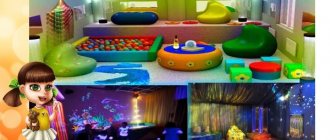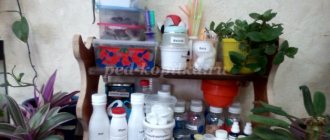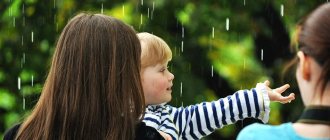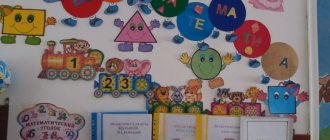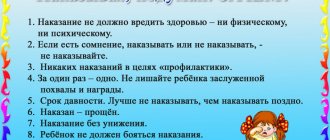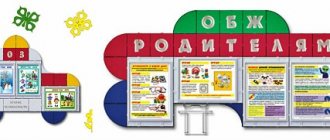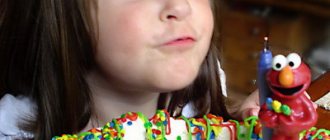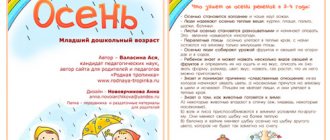Kindergarten is a child’s first social institution. Here he is constantly in the team, regardless of his thoughts, mood and experiences. At the same time, one of the tasks of a modern preschool institution is to ensure the emotional well-being of students. The development environment should facilitate this. In each group room, the teacher arranges a special place where the preschooler can be alone with himself, relax, and throw out negative emotions. Such an area is called a corner of solitude (or, according to the Federal State Educational Standard, a center of solitude and relaxation).
- 2 How to design a retreat center for preschoolers of different ages
2.1 What to make a frame for a corner of privacy from2.1.1 Photo gallery: types of frames for a corner of privacy
- 3.1 Passport of the corner of solitude
- 4.1 Items for expressing negative emotions
4.1.1 Photo gallery: objects for splashing out negative emotions
- 4.2.1 Photo gallery: items for relaxation and relaxation
- 4.3.1 Photo gallery: benefits for enriching the emotional sphere
- 5.1 Photo gallery: working in a corner of solitude
The purpose and objectives of creating a corner of solitude in a preschool educational institution
As the nervous system of a preschooler develops, his mental state is very unstable. It is easy to surprise, amuse, and offend a child. The teacher must be able to regulate the children's emotional sphere. After all, according to psychologists, suppression of emotions can provoke neurosis in its various manifestations. In no case should a child be shamed, much less punished, for showing feelings (anger, fear, wild fun, etc.), since he does not know how to control them due to his age.
Preschoolers should be taught to express negative emotions in constructive ways.
In order to provide children with psychological comfort, special corners of solitude, or relaxation zones, are created in preschool groups. A number of tasks are aimed at achieving this:
- In early preschool age, the main purpose of the retreat center is to facilitate the adaptation process, help children survive separation from their mother and get used to the teacher’s requirements. The corner of privacy is filled with objects for which the child has warm feelings; soft, beautiful pillows and toys will allow the baby to escape and relax.
- Teach your child to express his anger in an acceptable, safe form, and prevent excessive stimulation of the nervous system, which can lead to overwork. So, in the corner there may be special pillows for whipping, a box or glass where anger and resentment are thrown out, etc.
- Help preschoolers learn techniques for regulating their mood and ways to gain self-confidence. For this purpose, a mood board is placed in the corner, where you can draw your emotions or teaching aids, illustrations of various emotional experiences.
- Increase the self-esteem of anxious and shy children.
- Teach children to communicate without conflict with each other, to minimize possible quarrels in the children's team. An island of reconciliation will help with this - a special rug on which children peacefully resolve conflicts.
At a younger age, the teacher at the right time invites the child to go to a corner of solitude (for example, when he notices that he really misses his mother in the morning, feels squeezed, uncomfortable, or, on the contrary, behaves aggressively and offends other children). In the middle and senior levels, the children themselves already show a desire to go to the recreation area (and the teacher, in turn, does everything to ensure that they fall in love with this place). They already know perfectly well what can be done there and how to help themselves find peace or simply cheer up.
A preschooler may independently express a desire to go to a corner of solitude, or he may go there at the prompting of the teacher.
In the corner of solitude there should be objects that cause pleasant experiences in children, for example, balloons
"Center for solitude and relaxation"
“Center for solitude and relaxation as a means of emotional comfort for a preschooler”
Author:
Skvortsova Natalia Alexandrovna
Educator
MDOU No. 5 "Rainbow"
Tutaev
Relevance
In a kindergarten group, a child is in a group all day, regardless of his mood and experiences. Sometimes he gets tired of communicating with his peers, from games, from the environment, and sometimes he can show negative emotions: anger, malice, aggression, resentment. The behavior and mood of a child greatly depends on his emotional state. Therefore, the problem of the child’s emotional well-being becomes of great importance.
One of the tasks that the Federal State Educational Standard is aimed at is protecting and strengthening the mental health of children, including their emotional well-being.
There is a time when you want to be alone with your thoughts, experiences, mood, you want to relax. The child also has the right to this.
The development of a subject-spatial environment in accordance with the Federal State Educational Standard pays attention not only to ensuring joint activities of children and adults, physical activity of children, but also opportunities for their privacy.
Therefore, to solve this problem of combating negative emotions in children, I created the “Center for Solitude and Relaxation” in the group.
Target:
creation of personal space for the formation of the child’s emotional well-being.
Tasks:
- Expand the possibility of personal space in the group;
- Create an atmosphere of psychological comfort;
- Create conditions for mastering self-regulation techniques in children;
- Create a positive microclimate in the children's team.
Organization of a “Center for Solitude and Relaxation” in a group room
Types of retreat centers:
• “Mink” (younger age)
• “Tent” (middle, older age)
• “Screen” (used at any age, used where space does not allow)
Our center fits harmoniously into the group space. For decoration I used translucent fabrics; the principle of semi-openness was also used; if necessary, it can be closed.
The contents of the corner are periodically updated, but some items are constantly present, this gives children a sense of confidence and permanence.
Interaction between teacher and children
The teacher observes what the child does there, how much time he spends there and how often. The “Center for Solitude and Relaxation” may have a diagnostic and monitoring function.
The effectiveness of the work depends on how aware the children are of the purpose of the center, its equipment and ability to use the attributes. As new attributes are added, children are shown various types of activities with them.
Operation
"Center for Solitude and Relaxation"
The panel “Mood” depicts a mansion; when opening the doors of the mansion, the child improves fine motor skills (doors with zippers, buttons, cords, etc.) and sees emoticons with various emotions in transparent pockets, which he can distribute at his discretion in any house. Pictures in the houses can change, for example, emotions of boys, girls, funny, sad animals, postcards, etc. (This panel has one more function - it covers the screen with the battery).
Mirror of my mood. If a child is in a bad mood, he looks at himself in the mirror and smiles. Your mood will definitely improve.
Little heart. In the event of a conflict situation, quarrel or fight, they take the heart, stick their hands in and, with the help of the peace box, resolve their conflict.
“Hugging pillow” for relieving stress (with small balls), which you can press to yourself and move the small balls with your fingers, which also calms you down.
Didactic games (laces, beads, good-bad game, guess the emotion).
“Mood masks” that children can try on.
“Magic balls” B, in which there are balls of thread. This bunny comes to the rescue when children are angry, you can offer them to rewind the threads.
“Family Album” In the center of solitude, it is necessary to use those objects that are close to the child and give him a feeling of confidence. This could be an album with family photos.
We also placed a toy phone on which you can call mom or dad, grandma, etc.
Benefits for releasing negative emotions.
“Glass for anger” When aggression occurs, you can invite the child to leave all bad words and mood in this glass, then the glass is closed and hidden.
Rug of Anger An ordinary rug with a rough surface. A child without shoes wipes his feet until he wants to smile.
Development prospects
In the future, I plan to place a “Good Deeds” box, which will stimulate the desire in children to “do good.”
Conclusion:
A properly organized subject-development environment (Center for Solitude and Relaxation) will help children to be distracted and forget negative emotions and experiences, will help them understand the whole range of feelings that they experience, learn to evaluate actions, learn to interact with the teacher and peers, and this is precisely what lies at the basis of developmental education.
Literature:
— Belinskaya E.V. Fairytale trainings for preschoolers and primary schoolchildren, St. Petersburg: Speech; M.: Sfera, 2008. – 125 p.
— Danilina T.A., Zedgenidze V.Ya., Stepina N.M. In the world of children's emotions: A manual for practical workers of preschool educational institutions. – M.: Iris-press, 2004. – 160s – (Library of educational psychologist)
Internet resources:
— https://www.maam.ru/detskijsad/sozdanie-psihologicheskogo-komforta-detei-v-detskom-sadu.html
— https://festival.1september.ru/articles/628133/
-https://kopilkaurokov.ru/doshkolnoeobrazovanie/presentacii/ugholok-uiedinieniia-kak-odno-iz-uslovii-vniedrieniie-fgos-do
How to design a retreat center for preschoolers of different ages
When designing a corner of solitude in general, the teacher should focus on the age of the students. Thus, in the junior preschool level, the Mink design will be relevant - a small space with a small entrance that will give the child a feeling of comfort and safety. There, the baby will be able to sit or lie down in the company of plush toys that can be hugged (after all, tactile contact is very important at 3-4 years old) and other objects. Mandatory attributes of a “mink” are a soft rug and pillows.
For younger preschool age, the “Mink” design is relevant - a miniature tent house with a small entrance
For middle and older ages, the “Tent” design is suitable. The house will already be taller and more voluminous. The place of the small round entrance is taken by curtains or a screen. There are much fewer soft toys here (or maybe not at all). The design of such a zone gives the teacher the opportunity to show all his creativity and imagination. The tent can be transformed into a fairy-tale cave, a gnome’s house, a sunny room, an underwater kingdom, etc.
What to make a frame for a privacy corner from
Options for the frames of the privacy center can be different:
- A simple option - one corner of the group room is fenced off using a curtain attached to a cornice, or an ordinary screen. The fabric should be decorated with paper flowers, stars, butterflies, smiley faces, etc.
- You can build a house frame from plastic pipes and cover it with fabric.
- The role of the leading structure can be played by an ordinary large umbrella (the ideal option is a beach umbrella), to which a fabric or curtain made of ribbons is attached: this can look very original. You can also use a large lampshade.
If there is not a lot of space in the group, then you can use a screen to create a privacy zone. This is convenient because such a corner will be mobile: it can be moved from place to place at the request of the children and the teacher.
Using a screen, you can create a cozy place for privacy, complementing it with the necessary attributes
Photo gallery: types of frames for a corner of privacy
A corner separated by a curtain - a very simple and compact design
Plastic pipes covered with fabric create a stable structure
An umbrella with long ribbons sewn onto it is simply attached to the ceiling
A corner of a beach umbrella with ribbons looks like a carousel
If you attach a long translucent fabric to the lampshade, you will get a cozy corner of privacy
Photo gallery: ideas for decorating corners of privacy
In such a house, preschoolers will be able to feel like forest dwellers
Inside such a tent, a child seems to find himself in a magical world.
The screen transforms into a beautiful fairy-tale tower that can be moved from place to place
In such a house, a child will be able to imagine himself as a hero of a Russian folk tale.
Long multi-colored ribbons can serve as curtains
For older preschoolers, you can not completely fence off the area, but make a dome that symbolizes privacy
A luxurious princess tent can be made from ordinary tulle fabric
A beautiful tent is complemented by a soft clearing with a fence
When organizing a corner of privacy, you can use the space between children's furniture
Video: how to design a corner of privacy in kindergarten and at home
Video: Russian-style retreat called “Gorenka”
Best corner of solitude (viewing competition)
As you know, one of the important tasks of the educational process in a preschool educational institution is the formation and development of the emotional-volitional sphere of the child’s personality. The organization of the educational process is formed on the basis of deep respect for the child’s personality, taking into account the characteristics of his individual development, treating him as a conscious, independent person.
According to existing requirements, when organizing a developing subject-spatial environment in a preschool educational institution, it is necessary to create comfortable conditions not only for active activities of pupils, joint games, program classes, but also for psychological relief and recreation for children. psychological relief corners based on the group .
A corner of solitude is a place for peace and relaxation, personal secrets and fantasies. This is a place where you can remember your family, be sad and think, calm down and relax.
The psychological relief corner is designed to solve one of the important tasks of the preschool education standard - creating favorable conditions for the realization of the child’s individual need for peace. In accordance with this task, in our kindergarten from November 23-28, a review-competition of “Psychological relief corners” was held.
The goal of this competition is to create conditions for preserving the psychological health of every child.
Based on the goal, this competition solves the following problems :
1. Intensifying the activities of the teaching staff in the design and competent use of materials from psychological corners for the full psychophysical development of preschool children;
2. Involving parents in organizing the educational environment for children in preschool groups.
3. Increasing the competence of teachers in organizing a developing subject-spatial environment.
Among the main criteria for evaluating privacy corners were the following:
— presence in the group of a zone for psychological relief;
— availability of material to relieve aggression;
— availability of material for self-regulation;
— the presence of emotional and educational games aimed at teaching children conflict-free communication;
— the availability of material aimed at increasing self-esteem for anxious, insecure children;
— availability of material for teaching children the skills of cooperation and coordinated actions;
- aesthetic design of the psychological corner;
-creativity and originality in the design of the corner;
- environmental friendliness and safety of the materials used;
— compliance with sanitary and hygienic requirements;
— presentation of a corner of solitude by group teachers;
- children's story about a corner of solitude.
Teachers, together with parents and children, showed a creative approach to creating corners of solitude, carefully considering their appearance, shape and content, taking into account the age and individual characteristics of children of each age group. Everyone did their best! Wigs and tents, fabric and plastic houses, tents and screens, presented as corners of psychological relief, have found their place in each group of our kindergarten. And all kinds of “chants” and “mirilki”, various didactic games aimed at developing communication skills and teaching conflict-free behavior are just a small part of the attributes of the corners of solitude presented to the jury.
Each item presented in the corners has a specific function and meaning. For example, a child can always lie down and relax on soft, beautiful pillows; massage balls relieve muscle tension well, and crumb toys allow children to calm down and relax; Kaleidoscopes will certainly improve your mood, and soft huggable toys will become a child’s faithful friend.
Each group was able to create a unique “small world” for privacy, in which the child would feel calm, comfortable and safe.
No less interesting and educational were the presentations of corners of solitude. The kids vying with each other to talk about all the games and toys that populate the corner, how they like to relax in the “house,” and showed photographs of their beloved family.
To sum up the results of the competition, a jury consisting of:
Chairman of the jury - head Iskandirova T.A.
Jury members:
Deputy Head of Internal Affairs Domnina A.E.
Deputy Head According to the Department of Internal Affairs of MBDOU "Kindergarten No. 408 in Chelyabinsk" Goryanskaya N.V.
Teacher-psychologist Maltinikova N.P.
Teacher-psychologist Sevryugina E.A.
It is worth noting that all the corners of the solitude were decorated wonderfully, and the jury had a difficult choice to make. But nevertheless, according to the competent jury, the places were distributed as follows:
I place – groups No. 7, No. 12, No. 5, No. 2
II place - groups No. 10, No. 6
III place - No. 1, No. 8, No. 9
Congratulations to the winners!!!
And we express our gratitude to our children, parents and teachers for supporting the idea of the competition,
creative thoughts, making custom play equipment, love for children and kindergarten!
Rules for designing a corner of solitude according to the Federal State Educational Standard
The Federal State Educational Standard imposes certain requirements for the design of a corner of solitude in a preschool educational institution:
- It should not be too large in size (after all, it is a miniature house, marquee or tent that gives a child a feeling of comfort and tranquility).
- The color palette of the corner does not imply too bright colors; the lighting should be subdued.
- A soft rug and pillows are required on the floor (as an option - a child's chair), soft modules are welcome.
A fluffy rug, pillows, plush toys will create a feeling of coziness and comfort.
- The object environment in the corner should be of a developmental nature (and not just beautiful and cute little things that are pleasant to touch and look at) and encourage preschoolers to self-improvement and creativity.
- The filling of the relaxation zone should be varied. The teacher periodically changes the attributes for games, but some things are always present: this gives the child a sense of stability.
- When preparing manuals, the teacher must take into account the age characteristics of preschoolers. Toys, attributes and educational materials must also meet aesthetic and hygienic standards.
- We must never forget about safety precautions: sharp and easily breakable objects are not allowed in the corner.
So that the teacher can at any time make sure of the safety and normal well-being of the student, it is advisable to make a “window” in the corner of privacy that will not violate the child’s personal space.
By looking through the window, the teacher can quietly assess the child’s condition.
Passport of the corner of solitude
For each retreat and relaxation center, the teacher must issue a passport. The following points are stated there:
- Name of the zone (for example, “Island of Solitude”, “Cozy House”, “Nest”, “Relaxation Island”, etc.).
- The goals of organizing a corner of solitude and the specific tasks it performs.
- A list of equipment available in the corner and a brief description of how to interact with each teaching aid.
How to make a corner of privacy with your own hands
The Federal State Educational Standards standards impose certain requirements on the corner of solitude:
- The size of the corner of privacy should not be too large, since a feeling of peace and comfort for children is created by small shelters: houses, tents, tents.
- The color scheme of the privacy corner should be dim, the light dim, since the purpose of this place is to calm, pacify, and relax.
- There should be a rug or soft bedding and pillows on the floor.
- The items that fill the corner of solitude should be of a developmental nature, encouraging children to be creative and self-improvement.
- In a corner of solitude, to create a feeling of stability, a certain part of the objects should remain unchanged; the presence of the rest can be periodic, fueling preschoolers’ interest in this place.
- When creating a relaxation zone, educators should take into account the age of their charges. Toys must meet aesthetic and hygiene requirements.
- Safety requirements must be observed: no sharp or breakable objects.
Note! In the corner of privacy, you can make a window that allows you to periodically observe the child to make sure he is safe and well. However, it should not violate the baby’s personal space.
Ideas for decorating a corner
When creating the design of a corner of solitude, the teacher should focus on the age of his charges. For the younger group of preschool educational institutions, it is relevant to design a space with a low, narrow entrance. The child will feel comfortable and safe in such an environment.
Teaching preschoolers to read - what it gives and when you can start teaching
For other age groups, larger spaces such as a tent or house are suitable, the entrance to which can be curtained with a piece of fabric or covered with a screen. Instead of toys, in such an area you can place items exclusively for educational games or other activities:
- Games for developing emotionality (ready-made or homemade).
- Magical items that transform negative emotions into positive ones.
- Soft objects for hugging or hitting, depending on the surging emotions.
- Visual activity - draw your mood at the moment, or what mood the child wants to experience in the future.
- physical activity - various calming exercises or objects to improve fine motor skills.
Soft toys will come in handy
There can be several options for creating frames for tents:
- The most cost-effective option: fence off a corner of the common room with a screen or curtain. They can be decorated with flowers, stars, butterflies, and birds cut out of paper.
- The most convenient and original option for a tent is a large umbrella. It should be turned over and hung by the handle from the ceiling, which also does not require serious investments. A piece of fabric or a curtain of ribbons is attached to the umbrella.
- If there is not enough space in the room to accommodate a privacy zone, then you can use a screen as a fence. The location of such a zone can be changed at will;
- The simplest frame of the house in terms of execution is the version made of plastic pipes. The configuration of such a frame can also be made with your own hands and changed at will without any special financial or time costs.
A corner of privacy in a kindergarten made of plastic pipes
The use of ordinary plumbing plastic pipes to create a privacy zone in a kindergarten allows you to create many configurations: from locks to rockets. Everything is limited only by the designer’s own imagination. Using fabric or ribbons as drapery, you can give these plastic structures different looks.
The option made from PVC pipes will be budget-friendly
The big advantage for such structures is the ease of their installation and the mobility of the manufactured structures.
The transition from a family where the child was surrounded by his closest and dearest to a group of complete strangers is probably the first most severe shock for a child. Do not underestimate its effect on a fragile nervous system. Each child experiences this type of stress differently. The main task of an adult is to teach a child not to hide his emotions within himself, but to express them in such a way as not to harm himself or others who find themselves in a similar situation. And corners of solitude in kindergartens help solve this problem.
Filling the corner of solitude in kindergarten
The most important component of the recreation area is the objects that fill it. Three main groups can be distinguished here.
Items for expressing negative emotions
Pupils of preschool educational institutions can express negative experiences using a number of objects:
- Whipping pillows, crying pillows (to cry on).
- “A glass of anger” (alternatively, it could be a box, basket, chest, etc.). This is a beautifully designed glass (preferably with a black background) with a lid in which a child can leave his bad words and thoughts. When the baby speaks out, he closes the glass tightly and hides it.
- "Rug of Anger." This is a small rug made of coarse yarn or rough fabric. The preschooler takes off his shoes and wipes his feet until he stops being angry.
- "Island of Reconciliation" This is a small rug, beautifully designed, made by hand. The quarreling children stand up to him and resolve the conflict, making peace. For similar purposes, you can use a tube or mittens: a cardboard tube is interestingly painted or decorated with appliqué, two children each put their hand into the tube from their side, in the second case these are mittens tied with a string.
- Mirror for a good mood. When the teacher notices that the child is not in a good mood, he invites him to sit in the corner in front of the mirror, look at his reflection and smile.
- Mug "Shouter". As you know, when a person screams, negative emotions come out. In order not to create noise or frighten other children, the child is asked to shout into such a mug.
Photo gallery: objects for splashing out negative emotions
Looking at his reflection in a funny mirror, the baby calms down
Along with screaming, you can throw out anger and resentment
A pillow or soft module that can be beaten will help the child release anger and aggression
A child leaves his bad thoughts and feelings in a glass of anger
The purpose of such a little world is to transform children's conflict into an exciting action
Items that perform a calming and relaxation function
To relax preschoolers, the following can be used:
- Sensory toys. In younger preschool age, these are lacing, mosaics, wooden puzzles-insets. At an older age, you can add pictures here that the children form with their own hands: using Velcro, they attach individual elements (flowers, plants, insects) to the general background.
- Beautiful tabletop fountain, waterfall.
- Player with relaxation compositions: the sound of the sea, sounds of the forest, rain. At a younger age, the teacher turns it on; older preschoolers are able to do it independently.
- Musical toys (for example, a box), toys that make sounds (for younger preschoolers these can be ordinary “squeakers”).
- A photo album with group and family photos (it’s interesting to look at the families of all the pupils), photos of pets, an album with images of your favorite fairy tale and cartoon characters.
- A toy phone for imaginary calls to mom and dad.
- Massagers, small hedgehog balls, tactile bags (filled with sand, flour, cereal, salt, etc.).
- Collections of sea shells, magnets.
- A basket with balls of different colors and textures.
- Bottles with shower gel (you can dilute glycerin with water), in which beads and New Year's tinsel float. When the container is turned over, the elements fall down beautifully - watching this calms the nervous system.
- Materials for art activities (primarily for modeling - plasticine, colored dough).
Staying in a corner of solitude allows children to relax, recuperate, and interesting games help develop fine motor skills.
Photo gallery: items for relaxation and relaxation
Squeaker toys help little children calm down
Looking at a photo album helps a child calm down
A tabletop fountain or waterfall will have a fascinating effect on the child and will calm him down.
The picture can be decorated as you wish: the elements are attached with Velcro
An attractive pendant will interest the child and distract him from his worries.
Benefits for the development of the emotional sphere
The corner of solitude contains objects that help the child better understand his mood and well-being, as well as expand the range of emotional experiences:
- Didactic games: “Guess the emotion”, “Good and bad deeds”, “Emotions in fairy tales”, “My feelings”, “Events and emotions”. They can be purchased ready-made or made yourself.
- Masks (for example, a sad and cheerful clown), magic objects (hat, shoes, cloak, wand). The purpose of these items is to relieve the child of the feeling of constraint, constriction, and to help transform from sad to cheerful.
- “Mood cube”, on each side of which a certain emotion is depicted. The preschooler chooses the one that he feels at the moment or would like to feel. A similar manual is “Flower of Emotions.”
- "The Book of Kindness" This is an album with images of only good fairy tale and cartoon characters, plot pictures with scenes of good deeds.
- “Hug pillow.” If a whipping pillow provides an outlet for negative emotions, then this option allows the children to share their mood and talk about their dreams. For these purposes, you can use a doll (preferably a soft rag one).
The teacher thoroughly introduces students to each attribute and aid and demonstrates how to interact with it. After all, the effectiveness of a preschooler’s activity in a corner of solitude depends on this.
Photo gallery: benefits for enriching the emotional sphere
You can invite your child to put his bad mood in one bag and take a good one from another.
A child can tell a pillow about his mood and share his experiences.
The child chooses a mood that suits him and places a magnet with his photo there.
A funny hat will help your baby better understand his emotional state or try to feel some emotion.
Main activities in the retreat area
With each item and attribute, you can unfold an entire game in a corner of solitude. Everything here depends on the imagination and interest of the teacher. Let us outline the main directions:
- Object manipulation games. For example, “Tender Sun”. If a child is angry or too naughty, the teacher invites him to play in the corner with the rays of the toy sun - ribbons, twirling them around his fingers. This can also be done by 2 quarreling children at the same time: they play with ribbons while simultaneously saying kind words to each other. Another example is activities with colorful balls. Threads help a preschooler learn self-regulation techniques: when a baby winds threads into a ball, he calms down. Activities with yarn can be combined with reading a poem or singing a song.
- Didactic games. A child can independently play a board game to enrich the emotional sphere, for example, divide cards with images of good and bad deeds into 2 groups.
- Speech games using objects. For example, “My good deeds.” The teacher invites the student to remember his good deed and put the chip in a special box (everything is said out loud).
- Visual activity. For example, “Draw your mood” (the choice of color plays an important role here), “Draw or mold your fear from plasticine” (these are already elements of art therapy - then the baby can tear the picture and crush the plasticine figure into a ball).
- Physical activity. In older preschool age, in a corner of solitude, children can perform familiar finger or breathing exercises (card diagrams are useful here) and give themselves an acupressure massage. All this helps to relax and improve your emotional state.
In the corner of solitude, children play quiet games, engage in creative activities, quietly communicate, or simply take a break from the noise.
Photo gallery: working in a corner of solitude
To give vent to negative emotions, a preschooler can draw his fear or anger
Manipulations with ribbon rays will help calm or reconcile quarreling children
The child talks about his good deed and puts the chip in a special box
The game will help you understand positive and negative actions and evaluate your own behavior.
While staying within the preschool walls, children receive a huge amount of information and emotional impressions, which everyone perceives differently. The teacher's task is to help children put their thoughts and feelings in order. A cozy corner of privacy will help preschoolers gain self-confidence and give them a feeling of security. Depending on the age of the students, the teacher comes up with an interesting design for the “house”, selects the necessary attributes and didactic games, many of which are easy to make with your own hands. Based on them, children are offered effective activities that will help relieve stress and lift their spirits.

